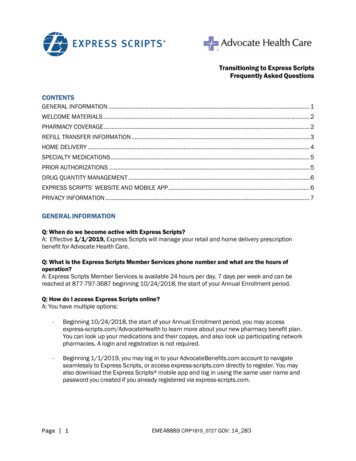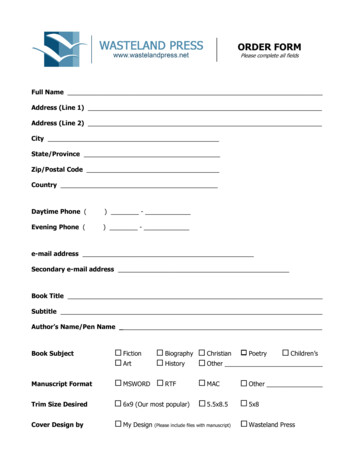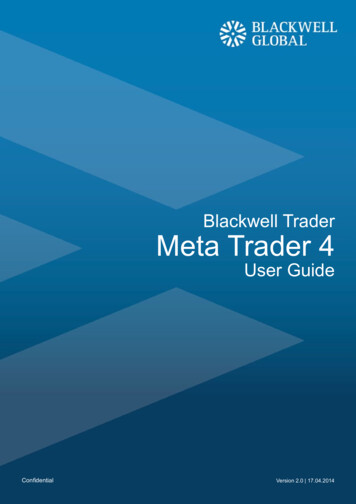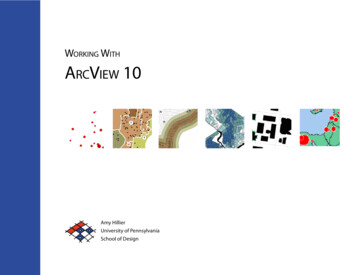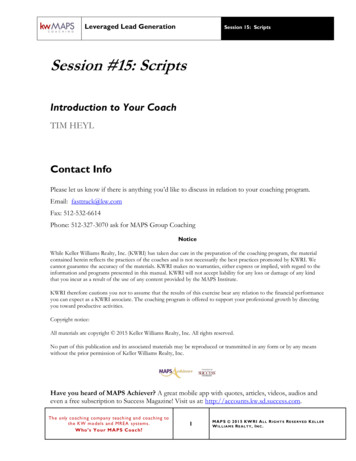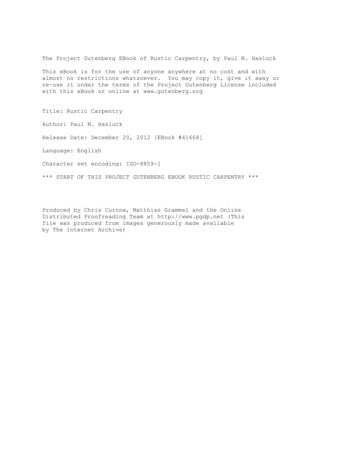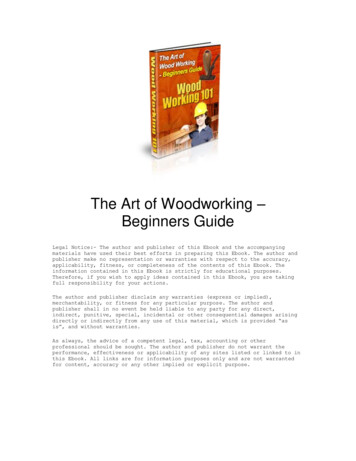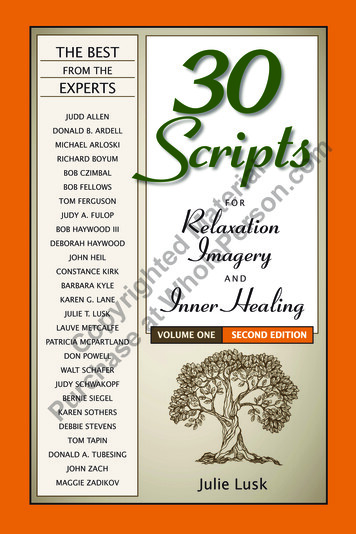
Transcription
rc Coha pse yriat ghW tedho Mle atPe errs ialon.com30criptsSforRelaxationImageryandInner Healingvolume one, second editionPuby Julie LuskDuluth, Minnesotai
rc Coha pse yriat ghW tedho Mle atPe errs ialon.comWhole Person101 W. 2nd St., Suite 203Duluth, MN son.com30 Scripts for Relaxation, Imagery & Inner HealingVolume One, Second EditionFirst Edition: 1992 by Julie T. LuskSecond Edition: 2015 by Julie T. LuskAll rights reserved. Except for short excerpts for reviewpurposes, no part of this book may be reproduced ortransmitted in any means, electronic or mechanical,including photocopying or recording without permissionin writing from the publisher.Printed in the United States of AmericaPu1 0 9 8 7 6 5 4 3 2 1Editor: Patrick GrossArt Director: Joy Morgan DeyLibrary of Congress Cataloging in Publication Data2014954305ISBN: 978-157025-323-2ii
rc Coha pse yriat ghW tedho Mle atPe errs ialon.comTo Angie Tapin,my constant source of inspiration,my mother, my friend,Puand to my husband Dave,who gives me love and supportin all that I do.iii
ContentsviiiIxForeword. . . . . . . . . . . . . . . . . . . . . . . . . . . VIIntroduction . . . . . . . . . . . . . . . . . . . . . . . . VIISection Onerc Coha pse yriat ghW tedho Mle atPe errs ialon.comBecoming Relaxed410141824Progressively Relaxing While Sitting in a ChairBreathing for Relaxation and Health1 to 10The Magic BallTotal RelaxationSection TwoNature and the Environment3235434952576164The SeaSimply SailingA Day in the Life of Another CreatureThe BeachFlying with the EagleOak CreekThe Night SkyOcean WavesSection ThreePuInner Answers727579824Your Inner AdvisorFortune CookiesYour Inner ChildTime Travel: So What Do You Want to Do for a Living?
Section FourHealingLove, Joy, and OptimismHealing Yourself and the UniverseSun Meditation for HealingVitamin T ImageryFood for Thought: Imagery for Weight ControlBreastfeedingrc Coha pse yriat ghW tedho Mle atPe errs ialon.com9097101104108113Section FivePersonal GrowthAddiction to WellnessBody Image VisualizationOM VisitationThe Blue PeriodYou Are a Child AgainFlower MeditationA Meditation of a World Vision149155ContributorsCross-Reference IndexPu1201241291311351381425
Forewordrc Coha pse yriat ghW tedho Mle atPe errs ialon.comRelaxation and visualization can heal the body,mind, and spirit. Progressive muscular relaxation andconscious breathing help relieve tension and stress.Guided imagery encourages people to experienceinternal harmony, to heal emotional and physicalupsets, to increase body awareness, to enhancerelaxation, to get in touch with the healing source ofenergy for emotional and spiritual strength, to receivedirection from their own inner guide, and to connectwith the environment.Many counselors, psychologists, teachers, ministers,and other professionals practice and use relaxation andguided imagery techniques with their clients, students,and patients. However, most use only a few, limitedvarieties—their favorites. That’s OK. These favoritesget honed and perfected and help the trainer help others.The problem in using only what we are familiar withis that we use only a small range of options availableto us and our clients. For this reason I asked leaders inthe field to share their favorite relaxation and imageryexercises—their best and most effective.PuI’ve compiled thirty scripts to expand your repertoire.I hope that these relaxation scripts, creativevisualizations, and guided meditations will not onlyspark your imagination but stimulate your creativityas well. Please feel free to add your own thoughts.Mix and match ideas and approaches—IMPROVISE!Modify the scripts to suit the needs of your groups,classes and your individual clients.Julie LuskJanuary 2015vi
IntroductionMany group leaders are aware of the benefits of guidedimagery but have had little experience in the field. Hereare some tips to help you use these scripts effectively.Working with guided meditationsrc Coha pse yriat ghW tedho Mle atPe errs ialon.comEveryone is different, so each person will experienceguided imagery uniquely. These individual differencesshould be encouraged. During a guided meditation,some people will imagine vivid scenes, colors, images,or sounds while others will focus on what they arefeeling, or experience it as a concept. This is why acombination of sights, sounds, and feelings has beenincorporated into the meditations. With practice,it is possible to expand your participants’ range ofawareness.By careful selection of images you can help deepentheir experience and cultivate their awareness in newareas that can enrich their lives. For instance, a personwho is most comfortable in the visual area can beencouraged to stretch his or her awareness and increasehis or her sensitivity to feelings and sounds. You’llfind an example of how this can be done in the FlowerMeditation script (Section 5).PuWorking with guided imagery is powerful and it isup to you to use this book responsibly and ethically.Leaders with little or no training in guided imagerycan use these scripts with emotionally healthy people.Be careful, however, when presenting themes andtechniques that are unfamiliar to you. Since peoplerespond in a variety of ways to visualization, avoidgeneralizing about the benefits of any given script.vii
If your groups are composed of people who areemotionally ill or especially fragile, you should seekout special training or professional guidance beforeintroducing them to visualizations.Preparing the group or individualrc Coha pse yriat ghW tedho Mle atPe errs ialon.comPhysical relaxation reduces anxiety, activates the mindbody connection, and enhances the ability to focuson mental images. Some type of physical relaxationsequence should be used prior to every guidedmeditation. You’ll find a variety of relaxation exercisesto choose from in Section 1.Breathing properly is essential for complete and totalrelaxation. Unfortunately, very few people take fullbreaths, especially when under stress. When a personconsciously uses deep breathing correctly, stress isreduced and the mind can remain calm and stable. It isimportant that people focus on their breathing, with fulldeep breaths through the nose.Before beginning any guided meditation, brieflydescribe the images you will use and ask if they makeanyone feel uncomfortable. People who are afraid ofwater may find images of ocean waves to be frighteningrather than calming. Be prepared with an alternateimage. Let participants know that if they becomeuncomfortable, they may, at any time, open their eyesand tune out or change the visualization.PuAs you read a script, people will follow you for a whileand then drift off into their own imaginations. Theywill usually tune you back in later on. If they knowthis in advance, they won’t feel as if they are failing bybeing inattentive. So tell them this is normal and to letit happen.viii
Choosing the right atmosphereSelect a room that has comfortable chairs for sitting ora carpeted floor for lying down. Close the door and shutthe windows to block out distracting noise.rc Coha pse yriat ghW tedho Mle atPe errs ialon.comIf possible, dim the lights to create a relaxingenvironment. Low lights enhance the ability to relaxby blocking out visual distractions. If the room lightscannot be controlled to your satisfaction, bring along alamp or night lights.Adjust the thermostat so that the room temperature iswarm and comfortable. If the room is too cool, it will behard to relax and remain focused. Suggest that peoplewear a sweater or jacket if they think they may get cold.If distractions occur—a noisy air conditioner, traffic,loud conversations—try raising your voice, usingshorter phrases and fewer pauses, or incorporating thesounds into the guided meditation. For example, youmight say, “Notice how the humming sounds of theair conditioner relax you more and more.” Or, “If yourmind begins to drift, gently bring it back to the sound ofmy voice.”Using your voiceSpeak in a calm comforting, and steady manner. Letyour voice flow. Your voice should be smooth andsomewhat monotonous. But don’t whisper.PuStart with your voice at a volume that can be easilyheard. As the guided meditation progresses and asthe participants’ awareness increases, you may beginspeaking more softly. As a person relaxes, hearingacuity can increase. Bring your voice up whensuggesting tension and bring it down when suggestingix
relaxation. Near the end of the guided meditation,return to using an easily heard volume. This will helpparticipants come back to normal wakefulness.rc Coha pse yriat ghW tedho Mle atPe errs ialon.comYou may tell participants to use a hand signal ifthey cannot hear you. Advise people with hearingproblems to sit close to you. Another option is tomove closer to them.Pacing yourselfRead the guided meditations slowly, but not so slowlythat you lose people. Begin at a conversational pace andslow down as the relaxation progresses. It’s easy to gotoo fast, so take your time. Don’t rush.The ellipses used throughout the book indicate abrief pause. Spaces between paragraphs suggest alonger pause.Leader’s notes and script divisions are printed in italicsand should not be read out loud.Give participants time to follow your instructions. Ifyou suggest that they wiggle their toes, watch them doso, then wait for them to stop wiggling their toes beforegoing on. When participants are relaxed and engagedin the imagery process, they have tapped into theirsubconscious (slow, rich, imagery) mind—and theyshouldn’t be hurried.PuWhen you’re leading the meditation, stay in yourconscious (alert and efficient) mind. Pay carefulattention to all participants. You may have to repeat aninstruction if you see that people are not following you.To help you with your volume and tone, pace andtiming, listen to a recording of yourself leading guidedmeditations.x
As you reach the end of a meditation, always helpparticipants make the transition back to the present. Tellthem to visualize their surroundings, to stretch, and tobreathe deeply. Repeat these instructions until everyoneis alert.Using musicrc Coha pse yriat ghW tedho Mle atPe errs ialon.comUsing music to enhance relaxation is not a new idea.History is full of examples of medicine men andwomen, philosophers, priests, scientists, and musicianswho used music to heal. In fact, music seems to be anavenue of communication for some people where noother avenues appear to exist.Your music should be cued up and ready to go at theright volume before you start your meditation. Nothingruins the atmosphere more quickly than the leaderhaving to fool around trying to get the music going.Jim Borling, a Board Certified Music Therapist, makesthe following suggestions on selecting music:PuTips on Music Selection Custom select music for individual clientsor classes whenever possible. Not everyoneresponds in a similar fashion to the samemusic. Matching a person’s present emotional statewith music is known as the ISO principle.If you can match the initial state and thengradually begin changing the music, theperson’s emotional state will change alongwith the music. If a person is agitated orangry, begin with faster-paced music, andthen change to slower-paced selections asrelaxation deepens.xi
Choose music that has flowing melodiesrather than disjointed and fragmentedmelodies.rc Coha pse yriat ghW tedho Mle atPe errs ialon.com Don’t assume that the type of music you findrelaxing will be relaxing to others. Have avariety of musical styles available and askyour clients for suggestions. Try using sounds from nature like oceanwaves. Experiment with New Age music andSpace music, much of which is appropriatefor relaxation work. Classical music maybe effective, especially movements that aremarked Largo or Adagio. Adjust the volume so that it doesn’t drown outyour voice. On the other hand, music that istoo soft may cause your listeners to strain tohear it. Select music based upon the mood desired.Sedative music is soothing and producesa contemplative mood. Stimulative musicincreases bodily energy and stimulates theemotions. Select music with a slow tempo and lowpitch. The higher the pitch or frequency of thesound, the more likely it will be irritating.PuProcessing the experienceYou may wish to add to the richness of the guidedmeditations by asking participants afterwards to sharetheir experiences with others. This can be facilitated bycreating an atmosphere of trust. Ask the group openended questions that relate to the theme of the exercise.xii
Be accepting and empathetic towards everyone. Respecteveryone’s comments and never be judgmental orcritical, even if people express negative reactions.Cautionrc Coha pse yriat ghW tedho Mle atPe errs ialon.comDo not force people to participate in anything that maybe uncomfortable for them. Give ample permission toeveryone to only do things that feel safe. Tell them thatif an image seems threatening, they can change it tosomething that feels right or they can stop the imagingprocess, stretch, and open their eyes. Emphasize toparticipants that they are in total control and are ableto leave their image-filled subconscious mind andreturn to their alert rational conscious mind at any timethey choose. Likewise, clients may want to explorewhat feels uncomfortable to them in the safety of theexperience.Advise participants that it is not safe to practicemeditation or visualization while driving or operatingmachinery.Recording the scriptsPuYou may record the scripts for your own personalor professional use. You may not, however, copy ordistribute the scripts to others electronically or inwritten form.xiii
30 Scripts: volume oneSection OneBecoming Relaxedrc Coha pse yriat ghW tedho Mle atPe errs ialon.comFeeling calm, relaxed, and centered is a foundation forany guided meditation. In fact, relaxation is healing in andof itself. Physically relaxing the body first, before usingguided imagery, increases people’s ability to concentrateand allows their minds, hearts, and spirits to be more opento the experience. A feeling of harmony often results.For many people relaxation is a new experience. It isimportant that people practice the physical form ofrelaxation and spend ample time with it until feelingrelaxed becomes natural and easy.PuThe exercises in this section focus on physical relaxation.Use them on their own or combine them with an imageryexercise from one of the other sections.2
section one:Becoming Relaxedrc Coha pse yriat ghW tedho Mle atPe errs ialon.comProgressively Relaxing while Sitting in a Chair. . . . . . 4Designed for people sitting in chairs, this progressiverelaxation exercise focuses on tensing and relaxing all thedifferent muscle groups. (20 minutes)Breathing for Relaxation and Health . . . . . . . . . . . . . 10Effective relaxation requires proper breathing. In thisscript, participants concentrate on their breathing byfocusing on what their bodies are doing as they breathe indeeply, hold it, and slowly exhale. (10 minutes)1 to 10 . . . . . . . . . . . . . . . . . . . . . . . . . . . . . . . . . . . . . . 14In this brief script, participants lie on their backs and tensetheir muscles as they count from 1 to 10, then release thetension as they count back down to 1. (5 minutes)The Magic Ball . . . . . . . . . . . . . . . . . . . . . . . . . . . . . . . 18In this visualization script, participants imagine they eachpossess a magic ball that travels over, under, and throughtheir bodies, relaxing their muscles as it moves.(20 minutes)PuTotal Relaxation . . . . . . . . . . . . . . . . . . . . . . . . . . . . . . 24An eclectic introduction to some of the most popularrelaxation techniques, Total Relaxation includes breathing,progressive relaxation, visualization, and body scanning.Use a part or all of this script as a short relaxationexercise prior to a guided meditation in one of the othersections of the book. (10 minutes)3
30 Scripts: volume oneProgressively Relaxingwhile Sitting in a ChairJulie LuskTime: 20 minutesrc Coha pse yriat ghW tedho Mle atPe errs ialon.comDesigned for people sitting in chairs, this progressiverelaxation exercise focuses on tensing and relaxing allthe different muscle groups.If time is short, it is okay to tense and relax each side ofthe body separately without tensing both sides together,or just tense the right and left sides at the same time.You may eliminate counting to five after you becomeaware of the length of time needed for your clients tofeel the tension and the relaxation and when they arecomfortable with doing the exercise.Note: Make sure participants have enough room tostretch their arms and legs straight out in front of them.Do not read the italicized headings out loud.ScriptPuShouldersLet’s begin, please allow your eyes to close or beslightly open and notice if you can begin feelingthe sensation of quieting into relaxation.Take in a big breath while bringing your shouldersup toward your ears.Now, drop your shoulders while releasing yourbreath.Let’s repeat, bringing fresh air inside yourself whilesqueezing your shoulders up towards your ears, and4
section one:Becoming Relaxedholding Now let your shoulders drop, relaxing asyour breath is released.rc Coha pse yriat ghW tedho Mle atPe errs ialon.comHands and ArmsHold your right arm straight out in front of youand make a tight fist. Hold it, tighter and tighter.1 2 3 4 5 Relax, dropping your hand toyour lap.Once again hold your right arm straight outin front of you, making a tight fist and hold.1.2 3 4 5 Relax and drop your hand toyour lap.This time, hold out your left arm and make a tightfist. 1 2 3 4 5 Relax and drop your handto your lap.Once again, hold out your left arm and make a tightfist. 1 2 3 4 5 Now relax. Let your armrelax completely, resting on your lap.PuLower ArmsHold your right arm straight out and bend yourwrist until your fingers point towards the ceiling.1 2 3 4 5 Relax, letting your arm fall toyour lap.Now hold your left arm straight out, bending thewrist with your fingers pointing toward the ceiling.1 2 3 4 5 Relax.You might be noticing a warm feeling in your arms.This time, hold both arms out in the same manner asbefore. Feel the tension in the upper portion of yourforearms. 1 2 3 4 5 Relax. Notice thefeeling of relaxation in your arms perhaps warmand tingly.5
30 Scripts: volume oneUpper ArmsNow it’s time to tense and relax your bicepmuscles. Bring the fingers of your right hand toyour right shoulder and tense your bicep muscle.1 2 3 4 5 Relax, letting your arm fall toyour lap.rc Coha pse yriat ghW tedho Mle atPe errs ialon.comNow bring the fingers of your left had toyour left shoulder, tensing and holding.1 2 3 4 5 Relax. Letting go.You might notice the feeling of relaxation in yourarms warm, heavy, and comfortable.ThighsDraw your attention to your thighs. Have both feeton the floor with uncrossed legs and feet. Press yourknees together so that the parts of your legs abovethe knees are touching. 1 2 3 4 5 Relax,letting go.Lower LegsFocus your attention on your lower legs Holdyour right leg straight out, point your toesforward, feeling the tension in your leg.1 2 3 4 5 Relax. Let your foot gentlyfall to the floor.PuNow hold your left leg straight out, point your toes,and tense. 1 2 3 4 5 Relax.This time, hold both legs straight out with your toespointing forward. Notice the tension in your calfmuscles. 1 2 3 4 5 Relax.Below the KneecapShift your attention to below your kneecap. Hold6
section one:Becoming Relaxedyour right leg straight out and point your toes backtoward your head. 1 2 3 4 5 Relax.Let go.This time, hold your left leg straight outand point your toes toward your head.1 2 3 4 5 Relax.rc Coha pse yriat ghW tedho Mle atPe errs ialon.comHold both legs out and point your toes towardyour head. Focus on the area below your kneecap.1 2 3 4 5 Relax.Notice how you’re feeling more and more relaxed.Perhaps your legs and arms feel heavy, warm, andrelaxed. Resolve to keep them still and relaxed, justfor now.AbdomenIt’s time to relax your abdominal region. Drawin your abdominal muscles as tightly as you can.1 2 3 4 5 Relax, feeling all of the knotsinside letting go.Now push your abdominal muscles outward as faras you can. 1 2 3 4 5 Relax. You’refeeling more and more relaxed.PuChestShift your attention to your chest. Take in a deepbreath and hold. 1 2 3 4 5 Let all of theair rush out, feeling more and more relaxed.NeckIt’s time to relax your neck. It’s important to learnto relax this area because a lot of tension canaccumulate here.7
30 Scripts: volume oneTip your head directly to the right side, moving yourright ear toward your right shoulder. Be careful notto strain. 1 2 3 4 5.Bring your head back up to center. Let it wobbleuntil it comes to a comfortable resting position.rc Coha pse yriat ghW tedho Mle atPe errs ialon.comNow let your left ear drop toward your left shoulder.1 2 3 4 5.Center your head and let it wobble untilcomfortable.To relax the muscles in the front of your neck, bendyour head forward and bring your chin toward yourchest. 1 2 3 4 5 Lift your head. Relax.Let your head wobble until comfortable.JawTo loosen up jaw tension, open your mouth andmove your jaw up and down and back and forth,working out all tension Relax. Let your teeth partslightly.MouthTo relax your mouth even more, press your lipstogether tightly. 1 2 3 4 5 Relax, lettingyour lips part slightly.PuNow bring your tongue upward and press it againstthe roof of your mouth. 1 2 3 4 5 Relax,letting your lips part slightly.Nose and CheeksTo relax your nose and cheeks, wrinkle up yournose and hold. 1 2 3 4 5 Relax.8
section one:Becoming RelaxedEyesTo relax your eyes, squeeze them tightly together.1 2 3 4 5 Relax.Foreheadrc Coha pse yriat ghW tedho Mle atPe errs ialon.comTo relax your forehead, frown and push youreyebrows downward. 1 2 3 4 5 Relax,letting go.Now draw your eyebrows upward.1 2 3 4 5 Relax, letting go.All OverIt’s now time to mentally scan your entire body. Ifyou notice any remaining tension, give that areapermission to relax and let go.You’re now very, very relaxed Let yourself enjoythis feeling Allow this feeling to sink in all over.PauseYou may continue on with a visualization exercisefrom another section of this book, or say thefollowing:Start to picture or sense the room you’re in thewalls, the ceiling, the floor.PuDescribe different aspects of the room.When you can picture or sense the room completely,open your eyes and stretch.Repeat the above instructions until everyone is alert.9
I hope that these relaxation scripts, creative visualizations, and guided meditations will not only spark your imagination but stimulate your creativity as well . Please feel free to add your own thoughts . Mix and match ideas and approaches—IMPROVISE! Modify the scripts to suit the ne
